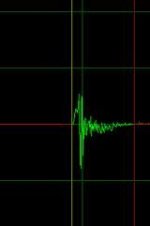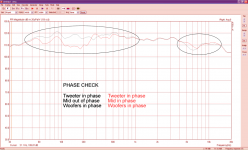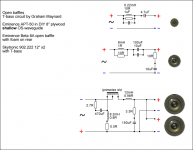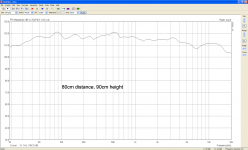Simon, I think you need to slow down, take a step back and just listen to some music. Then after you've heard them for a while, you can make a decision about how and where you want to improve.
The newest measurements where done at 60cm, instead of 30cm, so the curve is a bit flatter.
I remember Geddes saying that you should measure the waveguides even further away (1-2m).
It is the old small wg's.
I remember Geddes saying that you should measure the waveguides even further away (1-2m).
It is the old small wg's.
ra7, you're right, I need to have another listen and appreciate period and see what eventually annoys me.
Thanks for the info Kim. I didn't know they had to be measured from so far away, that is quite interesting.
Thanks for the info Kim. I didn't know they had to be measured from so far away, that is quite interesting.
I've been quiet because I've changed my power amps so am listening more and getting used to some changes. I'm selling my modified Marantz MA500s and am listening to a (modified) Carlsbro 800 PA amp. It's much cleaner and clearer in the bass and grips the woofers so well but the rest of the range leaves much to be desired, being a typical high power and cheap class A/B amp.
This amp is about to be relegated to bass-duties and my old dual mono LM3886 chip amp will drive the mids/tweeters. At first it will be using the passive crossover with the midrange resistors removed. The level will just be matched with pots/line-level attenuation. I'll give this a listen for a while and then get working on an active crossover. In the meantime I will get my other tweeter the same as the more tweaked one and try to decide if I can keep them or not. As they stand I'd rather be listening to basic silk dome tweeters for their smoothness...
Simon
This amp is about to be relegated to bass-duties and my old dual mono LM3886 chip amp will drive the mids/tweeters. At first it will be using the passive crossover with the midrange resistors removed. The level will just be matched with pots/line-level attenuation. I'll give this a listen for a while and then get working on an active crossover. In the meantime I will get my other tweeter the same as the more tweaked one and try to decide if I can keep them or not. As they stand I'd rather be listening to basic silk dome tweeters for their smoothness...
Simon
I finished rewiring things today 🙂
My woofers now run off a Carlsbro Powerline 800 (PA amp) and my mids and tweeters run off my DIY LM3886.
The Carlsbro has been upgraded with CMC binding posts, Wima decoupling caps on the output transistors, DIY stepped attenuators with Allen Bradley resistors and Elna Silmics on the main board. It sounds quite good now.
I've removed all padding resistors from the midrange and tweeter. Overall attenuation is done at line-level and by fluke the levels of mid and tweeter are great with no plain resistors. They're both dropped a bit by their own "shaping" filters - notch on tweeter and bass-boost on mid. These filters use good resistors (Kiwame on treble, Audio Note on mid) so they're hopefully not causing trouble.
I also took more measurements and messed with some parts again. I remembered how I changed the polarity of my mid driver to address a dip where it met the woofers. I put the polarity to standard to double-check this and again saw a big suck-out. I also noticed this reduced a suck-out I was getting at the top end where the mid meets tweeter. The solution was to change the polarity of the woofers (swap the speaker cables - easy!) and to leave the mids and tweets connected with normal polarity.
The sound is... great! Everything is a lot better now - smoother, cleaner and clearer with better dynamics and detail.
More to come later. I'm going to have fun putting some nicer resistors in my chip amp - which will eventually be changed for something like a DIY JLH 1969 class A amp.
My woofers now run off a Carlsbro Powerline 800 (PA amp) and my mids and tweeters run off my DIY LM3886.
The Carlsbro has been upgraded with CMC binding posts, Wima decoupling caps on the output transistors, DIY stepped attenuators with Allen Bradley resistors and Elna Silmics on the main board. It sounds quite good now.
I've removed all padding resistors from the midrange and tweeter. Overall attenuation is done at line-level and by fluke the levels of mid and tweeter are great with no plain resistors. They're both dropped a bit by their own "shaping" filters - notch on tweeter and bass-boost on mid. These filters use good resistors (Kiwame on treble, Audio Note on mid) so they're hopefully not causing trouble.
I also took more measurements and messed with some parts again. I remembered how I changed the polarity of my mid driver to address a dip where it met the woofers. I put the polarity to standard to double-check this and again saw a big suck-out. I also noticed this reduced a suck-out I was getting at the top end where the mid meets tweeter. The solution was to change the polarity of the woofers (swap the speaker cables - easy!) and to leave the mids and tweets connected with normal polarity.
The sound is... great! Everything is a lot better now - smoother, cleaner and clearer with better dynamics and detail.
More to come later. I'm going to have fun putting some nicer resistors in my chip amp - which will eventually be changed for something like a DIY JLH 1969 class A amp.
Here's the response with some tweeter filtering options. I'm listening to music with the notch filter at the moment and I think it's an improvement over leaving it alone.
Hi Simothy,
Why is there a +10dB bump at 500hz. baffle step?
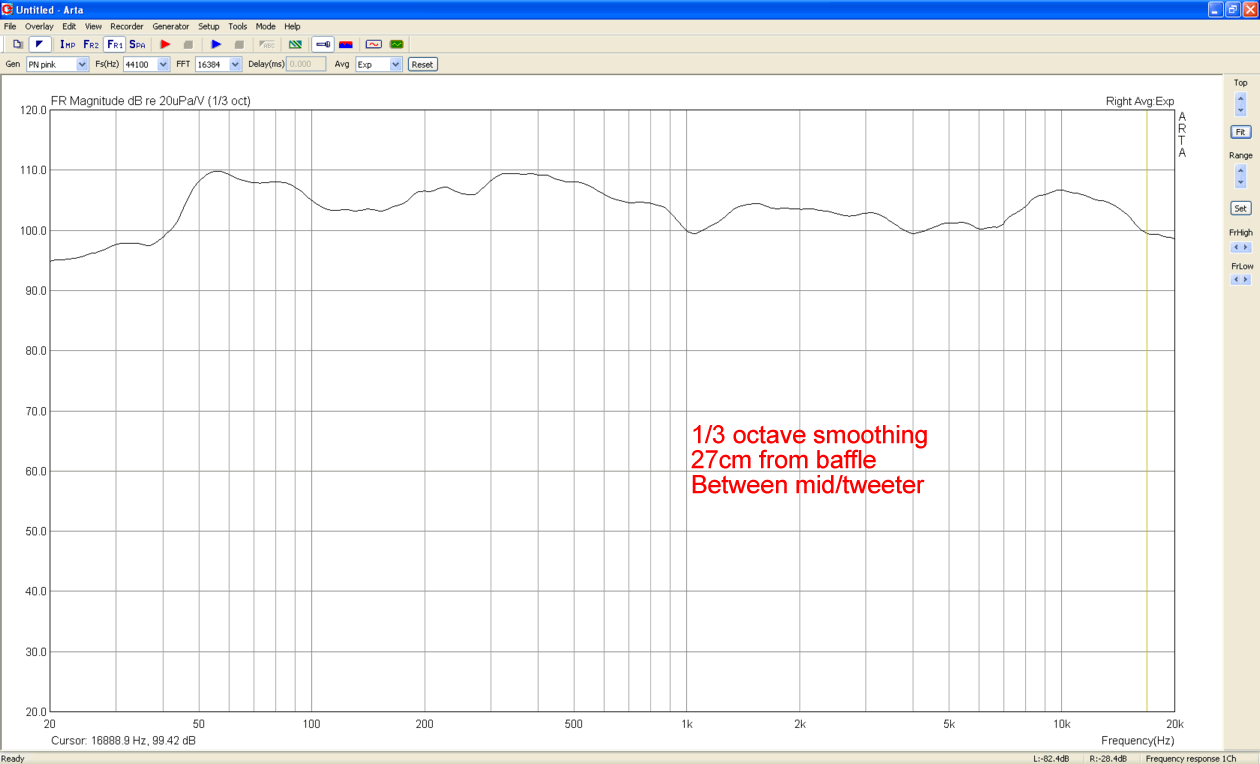
If you post your filter Maybe I have some suggestions to improve it.
On the impulse I can see problems with phase of the three drivers.
Measure it with a 20msec window 30cm 50cm 75cm 1mtr to.
Attachments
Last edited:
Hi Helmuth,
I will try to take the measurements you recommend, if I can work out how to do it. I appreciate you taking the time to look at and discuss my speakers.
I don't really agree there's a 10dB bump at 500hz (I suppose if you're comparing to 1khz we could say 5dB) but the area is certainly raised somewhat and it is due to the baffle width I believe. I expected issues when simulating in Edge. I have considered a notch filter but am yet to try this.
Attached is the graph I forgot to include earlier showing the cancellations I referred to. Now the graph is like a mix of both lines (the better parts).
Simon
I will try to take the measurements you recommend, if I can work out how to do it. I appreciate you taking the time to look at and discuss my speakers.
I don't really agree there's a 10dB bump at 500hz (I suppose if you're comparing to 1khz we could say 5dB) but the area is certainly raised somewhat and it is due to the baffle width I believe. I expected issues when simulating in Edge. I have considered a notch filter but am yet to try this.
Attached is the graph I forgot to include earlier showing the cancellations I referred to. Now the graph is like a mix of both lines (the better parts).
Simon
Attachments
Good that the system is getting better. I also think biamp is much better for an ob setup, to keep the damping resistors out of the system.
I've been smiling too, it sounds fairly good. There's always more to do of course. I'm looking forward to popping these Allen Bradley carbon resistors in my chip amp (feedback, input)... I have a special visitor tomorrow so need everything its best!!!
Ok that looks very good for a passive open baffle I think.Hi Helmuth,
I will try to take the measurements you recommend, if I can work out how to do it. I appreciate you taking the time to look at and discuss my speakers.
I don't really agree there's a 10dB bump at 500hz (I suppose if you're comparing to 1khz we could say 5dB) but the area is certainly raised somewhat and it is due to the baffle width I believe. I expected issues when simulating in Edge. I have considered a notch filter but am yet to try this.
Attached is the graph I forgot to include earlier showing the cancellations I referred to. Now the graph is like a mix of both lines (the better parts).
Simon
To control the rise at 500Hz would advise a L-C-R parallel to the mid driver.
2.2mH-30uF-and a R =0-8 Ohm you have to test what resistor will be the best value.
The rise can also be caused by the woofers then you need to parallel it to the woofers
Last edited:
It's funny because when I measured closer in this peak wasn't there. I suppose that almost confirms that it is due to the baffle shape - as close-up the shape will be seen much less in a FR measurements, I think.
Thanks for the filter suggestion. I was actually just working on something like that, using this calculator: 500 Internal Server Error (Amplitude Parallel Notch Circuit)
The problem I'm having is that to deal only with the peak and nothing else I need a 300uF cap. The 0.33mH coil and 4.7R resistor pose no problem as I have those.
Your parallel circuit uses more normal parts but I don't currently possess a 2.2mH coil
Would you say parallel has any better qualities other than component availability?
Thanks,
Simon
Thanks for the filter suggestion. I was actually just working on something like that, using this calculator: 500 Internal Server Error (Amplitude Parallel Notch Circuit)
The problem I'm having is that to deal only with the peak and nothing else I need a 300uF cap. The 0.33mH coil and 4.7R resistor pose no problem as I have those.
Your parallel circuit uses more normal parts but I don't currently possess a 2.2mH coil
Would you say parallel has any better qualities other than component availability?
Thanks,
Simon
WRT to this peak centred at ~520hz, the woofers do seem to be contributing to this, as can be seen on a recent graph showing two connection options (polarity of drivers). The peak is about 2dB lower when the woofers are out of phase with the mids, therefore cancelling some output in the area. A third pole of roll-off on the woofers would probably help and I think they're still contributing too much anyway... I am a bit hesitant to do this, though as I feel I'd be opening a new can of worms and with the prospect of going active on the low-mid x-o right on the horizon it seems like not the best time to further tweak this part of the crossover too heavily (at least not the slopes).
Last edited:
I'm not sure what that means 😕
BTW, I have a 2.7mH coil (air-cored) that I can use for testing. At the expense of another set of speakers (oops!) I can unwind it to get the desired L. Would 2.7mH get me in the right ball-park or must I start unwinding??
I might just go ahead and try this anyway and see what happens.
BTW, I have a 2.7mH coil (air-cored) that I can use for testing. At the expense of another set of speakers (oops!) I can unwind it to get the desired L. Would 2.7mH get me in the right ball-park or must I start unwinding??
I might just go ahead and try this anyway and see what happens.
3e3 is a dutch way of describing I think.I'm not sure what that means
3.3 Ohm the 4.7 Ohm parallel to that one.
Hi Simon, are you ever going to stop playing with these and just listen to the music ??😀😀?? LOL
Nope, probably not 😀
Though I am listening to Jennifer Warnes through them right now. Sounds well 🙂
Though I am listening to Jennifer Warnes through them right now. Sounds well 🙂
- Status
- Not open for further replies.
- Home
- Loudspeakers
- Multi-Way
- 3 way open baffle with Eminence and Skytronic
